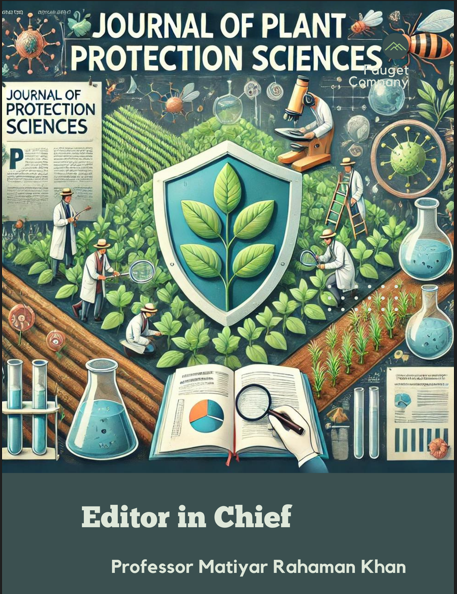Efficacy, stability and persistence of Ganosol, a Ganoderma based fungicide against plant pathogens
DOI:
https://doi.org/10.48165/Keywords:
Ganoderma, sheath blight, Groundnut Bud Necrosis virus, Ganosol, dual cultureAbstract
Ganoderma which was identified to have antifungal potential by dual culture technique against sheath blight pathogen of rice was developed as an emulsifiable concentrate. The formulation of 10EC at 0.25% was standardized as the best emulsifiable concentration for use against the pathogen. The pre inoculation spray of the formulation was observed to produce 63.62% reduction in lesion height caused by the sheath blight pathogen. Two isoforms of poly phenol oxidase, PPO 1 and PPO 3 were observed to be induced only in Ganosol 10EC sprayed plants and were absent in control. The formulation was tested to have good emulsion stability. The antifungal activity of the formu lation persisted up to seven days after spraying the formulation on rice plants. The formulation retained its 100% antifungal efficacy up to three months of storage. Surprisingly, spraying cowpea plants with the formulation as simultaneous spray reduced the number of lesions produced by Groundnut Bud Necrosis virus in cowpea by 88.39% when compared to the inoculated control, suggesting the antiviral potential of the formulation.
References
Ammermann E Lorenz G Schelberger K. 1992 BAS 490F - A broad spectrum fungicide with a new mode of action. In Proceedings of the Brighton Crop Protection Conference 1992 - Pests and Diseases. Vol. 1 British Crop Protection Coun
cil, Farnham, pp.403 -10.
Anke T Oberwinkler F Steglich W Schramm G. 1977 The strobilurins – new antifungal antibiotics from the Basidiomycete, Strobilurus tenacellus. Journal of Antibiotics 30: 806-10.
Backman PA. 1978 Fungicide formulation: relationship to biological activity. Annual Review of Phyto pathology 16: 211-37.
Badalyan SM Innocenti G Garibian NG. 2002 Antago nistic activity of xylotrophic mushrooms against pathogenic fungi of cereals in dual culture. Phy topathology Mediterranea 41: 220-25.
Bharathi S. 2004 Developing botanical formulations for the management of major fungal diseases of tomato and onion. Ph.D. Thesis, Tamil Nadu Agricultural University Coimbatore, India, 152p.
Burpee LL. 1998 Effects of plant growth regulators and fungicides on Rhizoctonia blight of tall fescue. Crop Protection 17: 503-07.
Dennis C Webster J. 1971 Antagonistic properties of specific group of Trichoderma I. Production of non- volatile antibiotics. Tranactions of the British Mycological Society 57: 25-39.
Gao Y Zhou S Huang M Xu A. 2003 Antibacterial and antiviral value of the genus Ganoderma P. Karst. species (Aphyllophoromycetideae): A Review. International Journal of Medicinal Mushrooms 5: 112.
Gareur VL Angioni A Real AA Russo M. 2002 Disap pearance of azoxystrobin, pyrimethanol, cyprodimil and fludioxonil on tomatoes in a green house. Journal of Agricultural Food Chemistry 50: 1929-32.
Hatvani N Kredics L Antal Z Mecs I. 2002 Changes in activity of extracellular enzymes in dual cultures of Lentinula edodes and mycoparasitic Tricho derma strains. Journal of Applied Microbiology 92: 415-23.
Hwang EI Yun B Kim Y K Kwon B M Kim HG Lee HB Jeong W Kim SV. 2000 Phellinsin A, a novel chitin synthase inhibitor produced by Phellinus sp. Journal of Antibiotics 53: 903-11.

